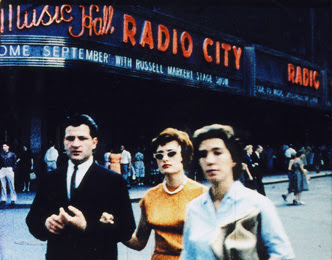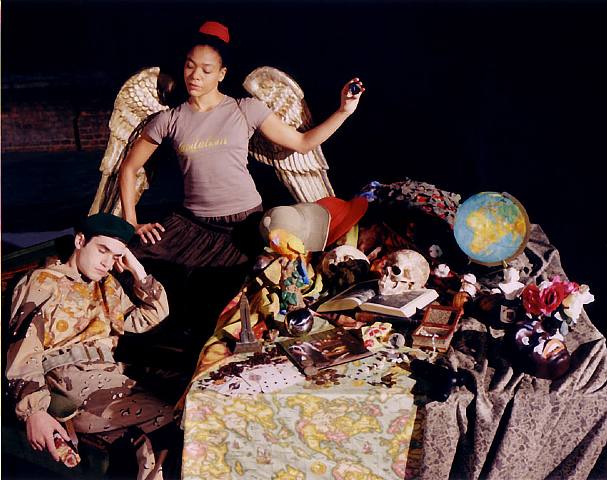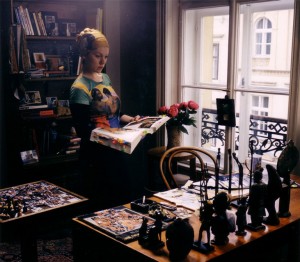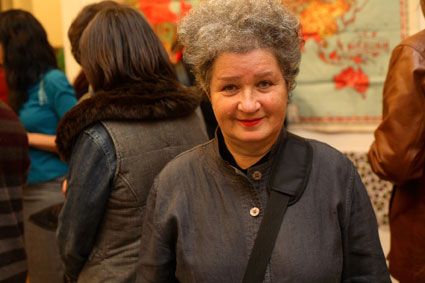I believe that this essay was completed in spring 2010 — for a rather formidable book about Austrian experimental film edited by Peter Tscherkassky, Film Unframed: A History of Austrian Avant-Garde Cinema, available here and here and here. — J.R.
1
The lessons available from Lisl Ponger’s cinema take many forms, but perhaps one could claim that most of them are separate versions of the same lesson — the lesson of coming to terms with our own ignorance. This is already apparent in the most elementary way in the earliest film of hers I’ve seen, Film — An Exercise in Illusion 1 (1980), a travelogue in which any precise sense of what it is that’s traveling — the camera? the camera’s aperture? the scenery? — becomes ambiguous. More specifically, if the essence of film in general and film illusion in particular is motion, these three minutes of silent, super-8 shots of Venice, filmed from a moving boat — or maybe it’s one shot and/or several moving boats — features movement within the camera as well as outside it, through extreme changes in light. Which is another way of saying that we don’t really know what we’re watching, even if it’s the nature of film illusion to persuade us that we think we know, conning us into superimposing some touristic narrative over whatever we’re seeing.
This lesson becomes more intricate — and is made far more explicit — three years later, in Ponger’s Film — An Exercise in Illusion 2. This time, the camera seems to be in the front of a moving train, and our sense of the passing scenery is complicated by an arcing rainbow seen in the upper left portion of the frame. But then a hand very quickly enters the frame at the upper right—so quickly that the illusion of a continuous take is instantly broken — and removes a transparent sheet of some kind in front of the camera that’s carrying the rainbow image. Then changes in light cause the picture to bleach out, followed by a shift to a blurry image that now appears to be moving in reverse. (Is it the film that’s running backward, or the train? Is any part of the footage being repeated?) Then a clear “window” appears successively in various portions of the blurred image, further confusing our overall sense of the frame as a window in its own right. And at the end, a left pan across a scenic vista arrives at what appears to be a “real” rainbow. But what do we mean at this point by “real”?
This is the question most of Ponger’s films ask — in one way or another, and at one point or another, even though their resemblance to an academic exercise in Film — An Exercise in Illusion 1 and 2 is usually left far behind. And the answer to that question typically turns out to be that we don’t know. One could argue, of course, that it’s the business of most artists to expose our ignorance, at least indirectly, by exposing us to things that we don’t already know, and getting us acquainted with the fact of our own ignorance is often the first, necessary step in this process.


By the time we arrive at Passages (1996) a decade later, Ponger’s methods for structuring the delayed recognition of our ignorance have become far more elaborate and taken on a good deal more ideological weight. From the beginning of that film, while we hear the voices of travelers recounting various details of their trips, we see various touristic images that momentarily seem to match these accounts but much more often collide with or contradict them. This evokes a lesson imparted by William S. Burroughs in the final section of The Ticket That Exploded (1968), a chapter entitled “the invisible generation”:
what we see is determined to a large extent by what we hearyou can verify this proposition by a simple experimentturn off the sound track on your television set and substitute an arbitrary sound track prerecorded on your tape recorder street sounds music conversation recordings of other television programsyou will find that the arbitrary sound track seems to be appropriate and is in fact determining your interpretation of the film track on screen people running for a bus in Piccadilly with a sound track of machine-gun fire looks like 1917 petrograde you can extend the experiment by using recorded material more or less appropriate to the film track for example take a political speech on television shut off sound track and substitute another speech you have prerecordedhardly tell the difference isn’t much record sound track of one danger man from uncle spy program run it in place of another and see if your friends can’t tell the differenceit’s all done with tape recordersconsider this machine and what it can do […] (1)
Thirty-three years ago, during my first quarter of film teaching, I terminally alienated some of my students in a lecture course on film esthetics with the following lesson in materialism. First I showed them Buñuel and Dali’s silent Un chien andalou several times, each time with a radically different musical accompaniment. Then I asked them on a quiz whether the statement, “The use of different kinds of music to accompany a silent film changes the film profoundly,” was true or false. Afterwards I explained to them that such a statement could only be false because the film remained the same regardless of whatever music accompanied it; the music changed only the way we looked at and ‘read’ the film, not the film itself.
I’m not recommending this as a teaching method, especially if one wants one’s contract renewed (mine wasn’t), but I’m bringing it up to illustrate the degree to which a certain amount of mystification about the relationship between image and sound is firmly entrenched in the way we routinely think about and experience film.
As a way of demonstrating how the ear leads the eye and vice versa, Michel Chion usefully begins his book Audio-Vision (2) with two modest proposals: that we analyze the opening nonnarrative sequence of Bergman’s Persona with and without the sound, and a characteristic naturalistic sequence on the beach in Tati’s Les Vacances de Monsieur Hulot with and without the image. In the first case, he observes that, without sound, not only does the first sequence of Persona lose its rhythms, its unity, and its meaning; it also looks different — a “shot” of a nail driven into a hand becomes three separate shots, and a narrative exposition of bodies in a morgue, without the sound of dripping water, becomes a disconnected series of stills without reference to either space or time. In the second case, the apparent boredom, discomfort, and inertia of vacationers witnessed on a beach becomes the sound of lively children enjoying themselves without the image to “mislead” us.
What Burroughs and Chion are both getting at in separate ways is our mental reflex to normalize and smooth over discontinuities between sound and image that yield what Ponger has already called film illusion, even before she started incorporated sound in her films. They’re both demonstrating that what we see or don’t see is largely determined by what we hear or don’t hear, and sometimes vice versa. We might even call it our propensity for converting films into “movies,” seamless blocks of narrative continuity, regardless of whether or not the separate materials actually belong together in any mutual
reinforcing fashion. And this becomes only the first step in an overall process of displacement and dislocation set up by Ponger in Passages that our brain typically seeks to “correct” by forging a more homogeneous block of time, space, and experience — an expedient illusion that serves our ideological assumptions about both the luxury of tourism and the horrors of involuntary exile by keeping them comfortably separate, at least until Ponger obliges us to recognize that we’re conning ourselves into believing that we’re seeing and hearing the accounts of tourists, not people forced into fleeing their homes. And this recognition is brought about in such a way that it creeps up on us only gradually.
The seductiveness of formulas of this kind shouldn’t lead to any attempts to divorce Ponger’s films either from her still photography or from some of her other relevant activities, such as selling second-hand clothes in Vienna’s flea market (a market she reportedly helped to establish in the 1970s). For instance, her ironic incorporation of herself in some of her so-called “travel’ photographs, with all the self-implication that this implies (e.g., in Gone Native, Out of Austria, The Big Game, and Lucky Us, all from 2000, and From the Wonderhouse, two years later), should be seen in contrast to her less exhibitionistic and more incidental appearance as part of a study group in her 2007 film Imago-Mundi. And arguably one could trace some of her flea-market orientation in her bricolage, her penchant for recycling some objects and materials in separate works, e.g. the way in which the photographic display of Fremndes Wien in 1991 becomes reconfigured in her 2004 film Phantom Foreign Vienna, or the way in which her 2005 photograph Destroy Capitalism [see below] appears to be an offshoot of her subsequent 2007 film Imago-Mundi.

2
Insofar as it’s also the business of criticism to teach us things we don’t already know — or else teach us things that we do already know, even if we don’t realize that we know them — it could be argued that art and criticism are fundamentally involved with the same agenda. But unfortunately, it’s the usual pretense of critics, whether they’re journalists or academics, that they’re imparting knowledge of some kind, not exposing their own ignorance. And it’s at this point that criticism and art, far from offering two separate versions of the same exploration, often wind up diverging, because the standard etiquette of criticism is to disavow positions of ignorance, not own up to them.
Furthermore, distinctions should be made between the kind of ignorance revealed to me by Ponger and the kind revealed to me by other critics writing about her films. When, in Souvenirs (1982), she cuts to create a kind of rhyme effect between a shot in color of a Nazi officer briefly hopping and a shot in black and white of a touristic photographer stooping down in a park to take a photo, various kinds of absent knowledge are being played with here — including (especially) the fact that the apparent Nazi officers being shown turn out to be, as we see in subsequent footage, extras in a film shoot, not real Nazis, and also including the fact that we don’t know exactly what the photographer in the park is photographing. But if I point out that Souvenirs begins with the camera moving around the exterior of a pre-Colombian temple, I can only say this because a catalogue description I’ve read tells me that this is a pre-Colombian temple; otherwise I wouldn’t have known (assuming that this identification is correct). And the first kind of ignorance is far more pertinent to Ponger’s project than the second.
Furthermore, it would be a serious mistake to assume that all of Ponger’s films can be identified by their uses of the viewer’s ignorance — even though this overall strategy reaches a certain apotheosis in her 23-minute déjà-vu (1999), and the issue of ideological innocence remains pivotal in the works that follow. But another climax is reached three years later in her 37-minute Imago Mundi – challenging what is accepted (2007), her longest film to date. Here the strategies come much closer to the challenging ways that Jean-Luc Godard in the 60s confronted his own viewers with various forms of cultural history and various ways of articulating that history in political and spatial terms—above all in La Chinoise (1967) and La Gai Savoir (1969), which also employed young performers at work and at leisure in claustrophobic surroundings (including a mutable studio space in the latter film), but also in Week End (1967) and 1+1 (1968, better known under its unauthorized version, Sympathy for the Devil). Here the rougher “underground” techniques and methodologies of Ponger’s earlier work are supplanted by the conditions of industrial filmmaking, including such screen credits as “makeup”, “costume”, “production manager”, and even “catering” — not to mention the employment of cinematographer Caroline Champetier, whose other credits include several Godard films, and other works by such filmmakers as Jean Eustache, Philippe Garrel, Jacques Rivette, and the team of Jean-Marie Straub and Danièle Huillet, all of whom straddle the usual divisions of industrial and experimental filmmaking. And, as with all these French-language filmmakers, extensive uses of citation or allusion are prominent: in this case, Spanish Baroque painter Antonio de Pereda’s canvas The Knight’s Dream (from the mid-17th century — a still-life imitated and “updated” in the film); a scene from Georg Büchner’s unfinished play Woyzeck (1836-1837), performed twice in succession; a passage read aloud from Dimitrie Dinev’s contemporary novel Engelszungen; and a closing printed quotation from a contemporary collection by bell hooks. Superficially, one might say that Imago-Mundi collapses time and history in much the same way that the earlier Phantom Foreign Vienna collapses space and geography, although in fact space-time and geography-history are creatively collapsed as well as expanded in both films. And in both cases, our ignorance as well as the means by which our limited knowledge is constructed becomes an integral part of Ponger’s subject.
But an actual manipulation of the viewer’s ignorance and innocence in déjà-vu is central to what this film is about and how it functions. To clarify precisely what the viewer is ignorant and innocent about, it would be helpful to quote a knowledgeable critic, Tim Sharp: “There are eleven native languages in déjà-vu, each reflecting a distinctive way of thinking and the cultural assumptions of those who speak them. Viewed historically, some of those languages (English, French, German, Portuguese) represent major export items — spreading the word with missionary zeal in the interest of the politics of power, economic efficiency and cultural presumption. In this post-colonial era we are still only half aware of the hierarchies which language creates. It is also worth consideringthe physical environment in which one watches the film. We are (willing) prisoners captured by flickering images. The soundtrack, however, turns us temporarily into colonial subjects. Fixed firmly in your seat you can escape neither the desire to understand, not the improbability of having mastered eleven languages. This linguistic helplessness, coupled with possible annoyance or frustration, creates an emotional counterpoint to the seductive nature of the images and reproduces on a small scale the feelings of puzzlement and powerlessness which is the daily fare of the colonized.” (3)


One of the most impressive achievements of Phantom Foreign Vienna (2004) — for me, Ponger’s masterpiece — is the way it combines the formal concerns of her earliest works with the postcolonial interrogations of such works as Souvenirs and déjà-vu. To suggest the material being worked with, we should turn again to the discourse of a knowledgeable critic — in this case a Brigitte Huck essay: “On a world journey through Vienna [Ponger] filmed over seventy different cultures and nations. She was present at a Philippine church service in the second district, at a New Year’s festival in a Sikh temple. She discovers Sudan and Ghana in the fourth district, and the Togolese living in the sixth. Vietnamese weddings; Taiwanese dance events; the Succoth festival at Beth Chabat, the Jewish school; the Swedish festival of light; Polish scouts; Croatian singers; Armenian clerics who commemorate the forty days of the Musa Dagh at Franz Werfel’s grave.’ (4)
This is an abbreviated summary of a compilation that can be described as genuinely global, even if the film paradoxically never extends beyond the boundaries of Vienna. And the key issue of how these separate documentations are combined — an issue that is simultaneously formal and ideological, an issue of mapping — is at the heart of the film’s activity. Narrating the footage in the separate German and English versions of the film, Ponger foregrounds this question by drawing information and anecdotes from her diary and her memories, recalling the methodology of Chris Marker (while retaining a first-person narration, unlike Marker). At first her ordering is chronological and set by her diary entries, then it becomes geographical (in relation to Vienna districts rather than the globe — Vienna in this case effectively, that is to say ideologically, becoming the globe), then it returns to chronology. Then she signals transitions determined formally, such as cutting from “orange to orange,” and, later, “the criteria of light, reflection, shadow,” then “the category of music”. This process becomes complicated further when the succession of one nationality after another becomes complicated by nationalities within nationalities (e.g., the “Swedish Saint Lucia celebration”). Then a series of different New Year celebrations (entailing separate New Years) is followed by cutting between separate Turkish weddings held a year apart in which the sound of one wedding is used to accompany the images of another. Finally, and climactically, Ponger announces, “When the background sound, the synchronized sound, and the image match up, the result is a filmic unity, a constructed reality” — in short, an ideology. And immediately afterwards, we’re offered images shot at the Peace Pagoda, background sounds taken from a BBC archive, and drum beats that were added later.
In fact, what Ponger is both explaining and demonstrating here is that maps of all kinds — meaning all systems of arrangements, including catalogues, exhibitions, and compilations — are ideological constructions. Some are voluntary and conscious and others are involuntary and unconscious, but all are profoundly political. And the exploration proposed by her cinema is ultimately spurred by how little we know about them.
Notes
- William S. Burroughs, The Ticket That Exploded, London: Corgi Books, 1968, 181.
- Michel Chion, Audio-Vision: Sound on Screen, translated and edited by Claudia Gorbman, New York: Columbia University Press, 1994, 3-4.
- Tim Sharp, “Travelling Shots: Notes on the films of Lisl Ponger” (a 2000 essay furnished to me by Sixpackfilm).
- Brigitte Huck, “Lisl Ponger,” essay included with the Index DVD of Ponger’s Passagen, déjà vu, and Phantom Frendes Wien (Travelling Light), 10.


